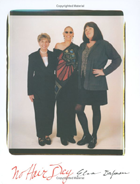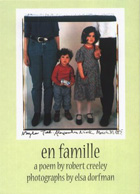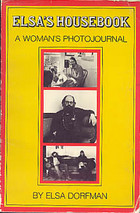Margaret Bourke-White, Review by Elsa Dorfman
by Vicki Goldberg.
New York: Harper and Row, 1986, 416 pp. $25.95 hard cover.
Margaret Bourke-White’s career as a photojournalist will remain unique in the history of photography because the mass media picture magazines for which she worked – Life and Fortune – no longer exist in their original form. Photography critic Vicki Goldberg has written the first full-length biography of Bourke-White, who died in 1971 but whose career was halted by Parkinson’s disease fourteen years earlier.
What is amazing about Margaret Bourke-White’s life is the number of opportunities she managed to get for herself. In photojournalism, getting where the action is, being there when it happens, is a major part of the talent and, ultimately, the achievement. And Bourke-White managed to get herself where things were happening when they were happening by working hard at being lucky and by her piercing intelligence and intuition. She was able to sense the potential of a great story and to get the editors of Life to transport her to the hot spot on time.
An incredibly hard worker with legendary stamina and perseverance, she was also charismatic and, by all accounts, beautiful. Inevitably, people wanted to help her, giving her story leads and access. (And she apparently had a sixth sense about who would turn out to be useful to her.) Like most photographers, she had the ability to focus her personality on the getting of the photograph – by being persuasive, charming, persistent, manipulative, whatever it took. On top of all this, she had an exalted view of the role of the photographer as witness and felt that “getting there” and sending back the word was a privilege and duty. This messianic view of her job must have given her a lot of energy. (This wasn’t as self-important an interpretation of the job of photojournalist as it might sound today: there was a world war raging, there was no television, no satellite transmissions to get the word out to the whole world within hours.)
Bourke-White had unbounded courage and never hesitated to jump into a dangerous situation. Like most war photographers, she thrived on adventure and crisis. There seemed to be no limit to how far she’d go for a photograph. I was aghast when I read Goldberg’s account of Bourke-White at Gandhi’s death. She had just said good-bye to Gandhi and was leaving India when she got word that he had been assassinated. She rushed to his house where his family and friends, who were her friends too, welcomed her in their sorrow. But no camera please. Unbelievably, Bourke-White had smuggled in a camera with her – and she actually popped off a shot, using a flashbulb, before her friends threw her out. By no means chagrined, she tried to get back in. Conflict between loyalty to friends and the demands of the work have been experienced by most photographers, but not many resolve it the way she did.
Goldberg follows the adventure chronology that Bourke-White herself established in her autobiography. (Portrait of Myself: The Autobiography of Margaret Bourke White, G.K. Hall, 1985). Born in 1904. Childhood in New Jersey. Workaholic father an inventor of printing presses and enthusiastic photographer. Graduation from Cornell in 1927, already secretly divorced. Opened a photo studio in Cleveland, Ohio. Her specialty: taking pictures of factories and mills. Found there by Henry Luce.
1930: took pictures of Russian industry. 1934: photographed the dust bowl for Fortune; so moved and appalled by the conditions that she decided to drop all her commercial photography accounts. 1936: met Erskine Caldwell and began work on You Have Seen Their Faces; and signed on as one of four photographers for the new magazine Henry Luce named Life. One of her images ended up on the first cover and inside was a series of her photographs with a text she had written – probably the first photo essay in an American publication. 1939: gave in and married Caldwell. 1943: covered the war in Italy. 1945: traveled with General Patton’s troops through Germany. 1946: ’47 and ’48: long visits to India. 1949 and 1950: covered South Africa. 1952 and 1953: covered Japan and Korea.
It was in 1953 in Korea that she felt the first symptoms of Parkinson’s disease. Stubbornly refusing to give in to her disabilities, she began her autobiography and worked for Life until 1957. In 1959 she had a then revolutionary operation (no longer performed) on the right cranial area of her brain to relieve the symptoms; in 1961 she had the same operation on the left side, but that procedure left her unable to speak without great difficulty for the rest of her life.
Goldberg’s biography depends heavily on the tales in Bourke-White’s autobiography and supplements them with material she gathered in interviews with those people who knew and worked with her. She accepts at face value most of the recollections of Bourke-White as arrogant, husband-stealing, demanding, manipulative. Though she is careful to quote many people who described Bourke-White as unforgettable and the most extraordinary person they had ever encountered, I had the feeling she didn’t quite believe them. She does a better job of incorporating all the jibes she gleaned in her interviews – mostly clever one-liners that make very good copy. Ironically, Bourke-White, who in her lifetime enjoyed the reputation that she could charm anyone, holds only a little charm for her biographer.
The first 25 years of the life are vivid because Goldberg had access to Bourke-White’s diaries from those years, now owned by a photography editor and a dealer. (Some time before she died, Bourke-White burned all the diaries and journals that were still in her possession. In her autobiography she did not draw upon her own diaries, perhaps she was writing after the diagnosis of Parkinson’s disease. She may have needed more than ever to cast herself as a lucky heroine. To remind herself of the vulnerability so apparent in her journals may have been the last thing she needed or wanted to do.)
Goldberg doesn’t try to probe the complicated Bourke-White, but decides early on that the clue to her persona is her relationship with her father, and his secret Jewishness, which was kept hidden from her until his death when she was eighteen (and which she in turn kept hidden from all but three or four friends). She is convinced that Bourke-White yearned for children and that her dedication to her work was overcompensation for her two failed marriages and two abortions. She never accepts the abortions as the rational acts of a woman who knows she is in an untenable marriage. In fact, Goldberg ignores her own evidence: in a telling footnote, she quotes Erskine Caldwell’s third wife, who says that Caldwell was the kind of man who always wanted his women to get pregnant when he felt he was losing his grip on them. Goldberg never analyzes why Bourke-White stayed with either of her two whiny husbands for as long as she did – and why she had to feel that her husbands needed her desperately and that only she could help them. (She actually left Life for a while because Caldwell didn’t like her running around covering a war.)
Goldberg doesn’t discuss the impact of Bourke-White’s demanding mother (other than her anti-Semitism) or the roots of Bourke-White’s attraction to dangerous situations. She doesn’t wonder why Bourke-White liked to promote the myth that she emerged with her full powers and conveniently forgot her long apprenticeship (which began with her helping her father as early as 1916). Her assumption is that Bourke-White’s way of working, her attitudes toward her work, the work itself, aren’t as interesting as the legends of her stamina and commitment to get herself to the scene of the news, her wartime exploits and her marriages and love affairs.
Goldberg adopts the critical assessment in trendy photographic circles that Bourke-White’s work can’t compare to the work of photographers who were her peers – Dorothea Lange, Walker Evans, W. Eugene Smith, Robert Capa, Ralph Steiner – or to the photographers who followed her – Robert Frank, Garry Winogrand. She doesn’t examine what’s behind this downgrading of Bourke-White’s reputation in the art world. (Do its roots lie in the competition between Bourke-White and Walker Evans and James Agee?) She begrudges the fact that Bourke-White invented herself and rewrote her history as she was poised on the brink of a big-time career. When Peg, daughter of Minnie Bourke and Joseph White, changes her name to Margaret Bourke-White, Goldberg treats it as the first in many acts of chicanery on her way to the top. But how can this compare with the transformation the Hungarian Andre Friedmann made into Goldberg’s hero, the American Robert Capa? Why not applaud Bourke-White’s myth of self as a nourishing act of inventiveness?
There are gaps in the research – very little from the archives of Life and Fortune about the way Bourke-White worked (aside from comments that she was demanding, used incredible amounts of film, etc.). There’s very little hard data about how many pictures she took, how many essays and covers she did for Life. There is little analysis of her working methods. There’s no analysis of Life and how the requirements of that magazine during wartime may have warped her photographic vision. There’s no discussion of the captions that went with her photographs and were an integral part of their presentation.
Was she happy or unhappy with the selection the editors of Life made of her work? (After all, she was usually on the other side of the world when her film arrived in New York in time for a deadline.) How much was her work affected by Life’s commitment to promoting national unity and a heroic identity during wartime? Was she thoughtful about her work? Did she ever look at it when she got home between assignments? Did she think about photography, talk about photography, think of photography as art, think of herself as an artist? Did she love photographic equipment (the way many photographers do) or was she afraid of it? Though her work exalted machinery and technology, she herself stayed with heavy, outdated cameras at a time when her colleagues were embracing 35mm. Goldberg doesn’t wonder why Bourke-White used so much film. Was it insecurity? Was it because she was mailing the film across the world to be processed? Was it because the competition between Life photographers was so fierce and she felt insecure about what she was getting? Did she get mesmerized by the act of photographing?
There is nothing from the archives of her publishers, Simon and Schuster, with whom she brought out six books, or Viking Press, which published two of her collaborations with Erskine Caldwell. There’s very little from Bourke-White’s correspondence; I wonder if she destroyed it when she destroyed her journals, or if there are restrictions on it, or if she just wasn’t much of a correspondent. There’s nothing from media interviews or lectures she gave during her life. We never know if Bourke-White met Amelia Earhart, Lillian Hellman, Margaret Mead, Gertrude Stein. We don’t know if she felt competitive with Marguerite Higgins, a much younger but equally beautiful and determined war correspondent for the New York Herald Tribune. There is very little about her relationships with other photographers, except that she drove them crazy. What did she think of Eugene Smith and his battles with Life? How did she get along with Walker Evans, Robert Capa? This book whets our appetite for more information, more details, the whole story.
Finally, Goldberg devotes 21 pages to the years from 1951 when Bourke-White felt the first symptoms of Parkinson’s disease to her death in 1971. During those years she put up an incredible fight, going public with the disease at a time when celebrities and public figures didn’t do that. Again, I wanted to know more. Maybe this phase of her life is as interesting as the years spent as an adventurer. She must have thought about the disease. She must have thought about the fight she was putting up. She must have thought about the sharp contrast with her previous years. Did she become at all religious? Did she reach some sort of resignation? Did her years in India and her Indian friends help her in her acceptance? Is the relentlessly upbeat tone of her autobiography her real voice?
Her telephone must have rung, she must have given interviews, she must have had guests. She must have had some contact with the people at Life. I wonder if she went over her body of work while she was ill, and what she thought of it. Did she meet young photographers, and what did she think of their work? Did she see Steichen, who lived close by (and who also had had an active career during the war)? Did she ever say what she might have done if she hadn’t been sick, or what she would like to have covered? How did she react to the politics of the sixties, a very photographic age? Was she at all intrigued by television?
This book is a teaser. It introduces us to a woman who managed to do things 30 years ago that would be tough for women photojournalists to accomplish today. It tells us a lot of what she did and who she met and where she went. It tells us a little of what she thought about what she was doing. It made me want to see videotapes of Bourke-White, hear her voice, know more about her, go to the library and find all her work buried in issues of Life. Ferret out any correspondence. Find out if anyone penetrating interviewed her (Studs Terkel? Edward R. Murrow?). Find out how she managed during those nineteen years of incapacity. But Goldberg’s book is good for starters; and it may be the only biography of Margaret Bourke-White we will ever get.





